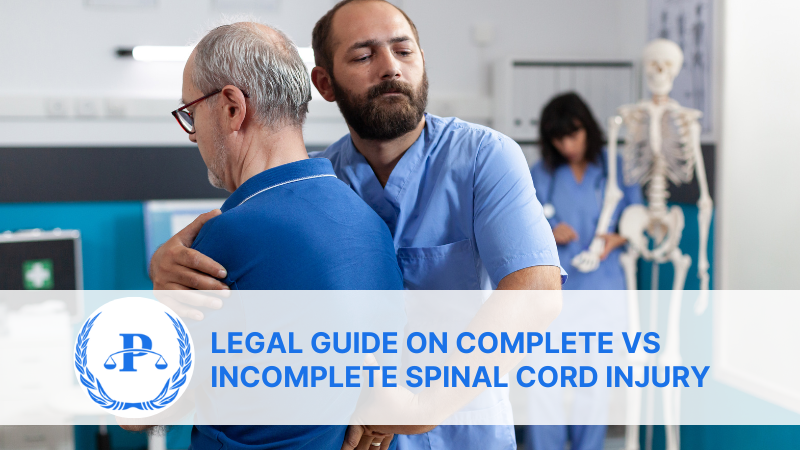SCIs are among the worst and most life-altering conditions. Understanding Complete vs incomplete spinal cord injury is critical in California, where personal injury litigation and accident rates are high. Understanding the essential differences can assist accident victims, families, and workers comp attorney California in making better medical and legal decisions.
Understanding Spinal Cord Injuries
The spinal cord, a central nervous system component, is in the vertebral column. It communicates with the brain and body for movement, sensation, and reflexes. Spinal cord injuries disrupt these signals, producing sensory, motor, and even full paralysis. Damage and functional loss of income that classify spinal cord injuries as full or incomplete.
Complete Spinal Cord Injury
After a full spinal cord injury, sensory and motor function below the lesion site is gone. The affected parts are paralyzed because the brain and body cannot communicate below the Traumatic Injury.
Here are the Complete Spinal Cord Injury Characteristics:
- Complete Function Loss: The injured spinal cord segments cannot move or feel.
- Complete Paralysis: SCIs paralyze below the injury. The injury may paralyze arms, legs, or respiration.
- Sensory Impaired: The wounded area cannot feel, warm, or hurt.
- No voluntary movement: Walking or grabbing are impossible below the injury.
- Possible Problems: Complete SCI can cause respiratory failure, pressure sores, muscular atrophy, UTIs, and gastrointestinal difficulties.
Incomplete Spinal Cord Injury
Partial spinal cord injury is incomplete. Some function below the injury is preserved, but the disability may vary substantially. Incomplete injuries may restore motor or sensory functions.
Here are the Incomplete Spinal Cord Injury Features:
- Partial Loss of Function: Incomplete SCI patients have some motor or sensory function.
- Sensory and Motor Function: Preserved function varies substantially. Others may partially function or regain mobility or sensation.
- Ensures Medical Treatment: Incomplete spinal cord injuries recover better. Medical treatments and rehabilitation services may restore lost functions.
- Better Rehabilitation: Incomplete spinal cord injury patients often have better long-term outcomes than complete SCI patients, despite extensive recovery times.
- Maintains Result: Incomplete spinal cord injuries include Central Cord Syndrome, the most common and generally caused by neck trauma. Arm and leg weakness and maintained feeling result.
- Brown-Séquard Syndrome: One side of the spinal cord is paralyzed and loses sensation while the other is normal.
- Produces Motor Function Loss: This frontal spinal cord lesion produces motor function loss, pain/temperature below the injury site, light touch, and proscription.
- Ensures Vibration: This rare lesion causes loss of vibration and location awareness below the Spinal Cord Damage, although motor function is normally intact.
Legal Implications of Complete vs Incomplete Spinal Cord Injury
The severity of an injury—whether complete vs incomplete spinal cord injury—has profound implications for both the victim and their Legal Representation. In California, spinal cord injury victims may be entitled to significant compensation, but understanding the type and extent of the injury is crucial for determining the potential damages.
Key Legal Considerations:
- Establishing Liability: In personal injury cases, the complete vs incomplete spinal cord injury classification is vital for determining who is responsible. If the injury results from negligence, such as in a car crash or workplace accident, the extent of the injury will impact disability claims.
- Compensation Assessment: In Complete vs incomplete spinal cord injury, victims with complete spinal cord injury generally have higher medical costs, long-term care needs, and a more severe prognosis than those with incomplete spinal cord injury. The level of disability, lost wages, future medical expenses, and pain and suffering will influence the legal compensation amount.
- Medical Expert Testimony: Legal consultation cases involving complete vs incomplete spinal cord injury often require expert testimony from medical professionals who can assess the level of damage and predict the long-term outcomes for the victim.
- Long-Term Care Needs: The type of injury in Complete vs incomplete spinal cord injury also dictates the extent of long-term care required. Individuals with complete spinal cord injury often need 24/7 care and assistance with daily activities, while those with incomplete injuries may regain some independence.
Rehabilitation and Support in California
Complete or incomplete spinal cord injury recovery requires medical and treatment. California has various rehabilitation centers that help people regain mobility, independence, and quality of life.
- Physical Therapy: Customized programs improve strength, mobility, and flexibility to preserve function.
- Occupational Therapy: Instruction in clothing, cooking, and housework.
- Speech therapy: It aids swallowing and communication after high cervical spinal cord injury.
- Psychological Support: Counseling to help spinal cord damage sufferers deal emotionally.
- Assistive Devices: Wheelchairs, braces, and adaptive tools that help people regain independence.
Conclusion
California victims, families, doctors, and workers’ compensation lawyers must grasp complete and incomplete spinal cord injuries. Either a complete or incomplete SCI produces paralysis or permits rehabilitation; the injury is terrible. Recovery might be difficult, but with the correct medical, rehabilitation, and legal help, people can regain independence and function. Those harmed should seek experienced medical treatment, legal representation, and emotional support to maximize healing and compensation. At the Law Office of Spiro K Pistiolas, A Workers’ Compensation Attorney, we represent the best workers comp lawyers who have handled a wide range of cases which ensures complete vs incomplete spinal cord injury. Get in touch with us today at (844) 414-1768!












